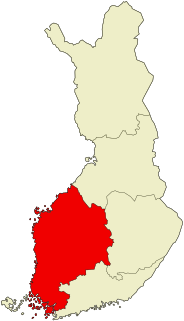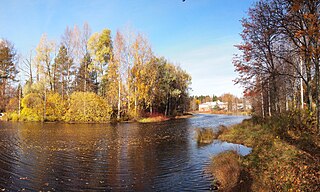
Western Finland was a province of Finland from 1997 to 2009. It bordered the provinces of Oulu, Eastern Finland and Southern Finland. It also bordered the Gulf of Bothnia towards Åland. Tampere was the largest city of the province.
The former Province of Western Finland in Finland was divided into seven regions, 34 districts and 192 municipalities.

Juupajoki is a municipality of Finland. It is located in the Pirkanmaa region. The municipality has a population of 1,780, which makes it the smallest municipality in Pirkanmaa in terms of population. It covers an area of 274.95 square kilometres (106.16 sq mi) of which 16.47 km2 (6.36 sq mi) is water. The population density is 6.89 inhabitants per square kilometre (17.8/sq mi). Korkeakoski is the administrative center of the municipality.

Keuruu is a town and municipality of Finland. It is located in the province of Western Finland and is part of the Central Finland region. The municipality has a population of 9,441 and covers an area of 1,430.57 square kilometres (552.35 sq mi) of which 172.4 km2 (66.6 sq mi) is water. The population density is 7.5 inhabitants per square kilometre (19/sq mi). The town center and Haapamäki village are both the most populated places in Keuruu.

Ruovesi is a municipality of Finland.

Sysmä is a municipality of Finland. It is situated in the Päijät-Häme region. The municipality has a population of 3,583 (31 December 2021) and covers an area of 936.18 square kilometres (361.46 sq mi) of which 269.14 km2 (103.92 sq mi) is water. The population density is 5.37 inhabitants per square kilometre (13.9/sq mi). Neighbouring municipalities are Asikkala, Hartola, Heinola, Kuhmoinen, Luhanka, and Padasjoki. The municipality is unilingually Finnish.

Virrat is a town and municipality of Finland. It is part of the Pirkanmaa region, and it is located 104 kilometres (65 mi) north of Tampere and 113 kilometres (70 mi) west of Jyväskylä. The distance between Virrat and Helsinki is 285 kilometres (177 mi). The town has a population of 6,462 (31 December 2021) and covers an area of 1,299.07 square kilometres (501.57 sq mi) of which 136.73 km2 (52.79 sq mi) is water. The population density is 5.56 inhabitants per square kilometre (14.4/sq mi). The municipality is unilingually Finnish.

Koskenpää is a village and former municipality of Finland in the Central Finland region. It was consolidated with Jämsänkoski in 1969, which in turn was consolidated with Jämsä in 2009.

Purmo is a former municipality of Finland. It was incorporated into the rural municipality of Pedersöre in Ostrobothnia in 1977. Purmo is home to a wooden church built by Antti Hakola in 1772. Approximately 1,400 people live in Purmo and like in Pedersöre, they are mainly Swedish-speaking.

Mänttä-Vilppula is a town and municipality of Finland. The municipalities of Mänttä and Vilppula were consolidated into a single municipality on January 1, 2009. It is located in the Pirkanmaa region.
Tarjanne is a medium-sized lake in Finland. It is situated in the municipalities of Ruovesi, Virrat and Mänttä-Vilppula in the Pirkanmaa region in western Finland. The lake is part of the Kokemäenjoki basin. The main inflows are the lake Vaskivesi and a chain of lakes north of it in the west and a chain of lakes from the lake Pihlajavesi in the north. The lake drains into the Lake Ruovesi in the south.

Tampere University of Applied Sciences is a university of applied sciences in the region of Pirkanmaa, Finland. Together with Tampere University, TAMK constitutes the Tampere higher education community.

Itä-Häme is the eastern part of the historical province Tavastia in Finland. It is in Päijänne Tavastia, Southern Savonia and Central Finland.

Pihlajavesi is a town and a former municipality of Finland, which in 1969 was merged into the municipality of Keuruu, located in the Central Finland region.

Aitoo is a village of the Pälkäne municipality in Pirkanmaa, Finland. At the end of 2020, the village had 2,569 inhabitants. Aitoo is located 15 kilometres (9.3 mi) east of Onkkaala, the municipal center of Pälkäne, along the regional road 322.

Palokka is a district of Jyväskylä and the largest area by population in the Palokka-Puuppola ward. Prior to 2009, it was a part of Jyväskylän maalaiskunta. The greater Palokka area has a population of ~14000. Palokka is approximately 5 km to the north of central Jyväskylä.

Konginkangas is a settlement and former municipality of Finland in the Central Finland region. It was consolidated with Äänekoski in 1993.

Pattijoki is a settlement and former municipality in Finland. It was a part of the Oulu Province, but now located in the region of Northern Ostrobothnia. It was consolidated with the town of Raahe in 2003.

Tyrväntö is a former municipality of Finland in the Häme Province, now in Tavastia Proper. It was consolidated with Hattula in 1971. The northern part of the former municipality was transferred to Valkeakoski in 1978.

Koijärvi is a former municipality of Finland in the former Häme Province, now in Tavastia Proper. It was split between Forssa and Urjala in 1969, most of the land was given to Forssa.





















